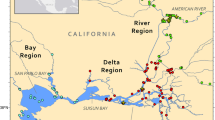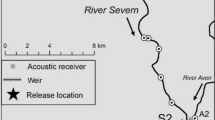Abstract
Surubim, Pseudoplatystoma corruscans, is the most valuable commercial and recreational fish in the São Francisco River, but little is known about adult migration and spawning. Movements of 24 females (9.5–29.0 kg), which were radio-tagged just downstream of Três Marias Dam (TMD) at river kilometer 2,109 and at Pirapora Rapids (PR) 129 km downstream of TMD, suggest the following conceptual model of adult female migration and spawning. The tagged surubims used only 274 km of the main stem downstream of TMD and two tributaries, the Velhas and Abaeté rivers. Migration style was dualistic with non-migratory (resident) and migratory fish. Pre-spawning females swam at ground speeds of up to 31 km day-1 in late September–December to pre-spawning staging sites located 0–11 km from the spawning ground. In the spawning season (November–March), pre-spawning females migrated back and forth from nearby pre-spawning staging sites to PR for short visits to spawn, mostly during floods. Multiple visits to the spawning site suggest surubim is a multiple spawner. Most post-spawning surubims left the spawning ground to forage elsewhere, but some stayed at the spawning site until the next spawning season. Post-spawning migrants swam up or downstream at ground speeds up to 29 km day-1 during January–March. Construction of proposed dams in the main stem and tributaries downstream of TMD will greatly reduce surubim abundance by blocking migrations and changing the river into reservoirs that eliminate riverine spawning and non-spawning habitats, and possibly, cause extirpation of populations.






Similar content being viewed by others
References
Barthem R, Goulding M (1997) The catfish connection. Columbia University Press, New York
Bazzoli N (2003) Reproductive parameters of fishes of commercial interest at Pirapora region. In: Godinho HP, Godinho AL (eds) Waters, fishes, and fishermen of the São Francisco of Minas Gerais. PUC Minas, Belo Horizonte, Brazil, pp 291–306 (in Portuguese)
Borenstein M, Cohen J (1988) Statistical power analysis: a computer program. Lawrence Erlbaum Associates, Hillsdale, NJ
Brito MFG, Bazzoli N (2003) Reproduction of the surubim catfish (Pisces, Pimelodidae) in the São Francisco River, Pirapora Region, Minas Gerais, Brazil. Arq Bras Med Veterinária e Zootecnia 55:624–633
Carolsfeld J, Harvey B, Ross C, Baer A (eds) (2003) Migratory fishes of South America. World Fisheries Trust, Victoria, BC
Cohen J (1988) Statistical power analysis for the behavioral sciences. 2nd edn. Lawrence Erlbaum Associates, Hillsdale, NJ
Gerking SD (1959) The restricted movement of fish populations. Biol Rev 34:221–242
Godinho AL, Godinho HP (2003) Brief vision on the São Francisco. In: Godinho HP, Godinho AL (eds) Waters, fishes, and fishermen of the São Francisco of Minas Gerais. PUC Minas, Belo Horizonte, Brazil, pp 15–24 (in Portuguese)
Godinho AL, Kynard B (2006) Migration and spawning of radio-tagged zulega (Prochilodus argenteus, Prochilodontidae) in a dammed Brazilian River. Trans Am Fish Soc 135:811–824
Godinho AL, Kynard B, Martinez CB (in press) Supplemental water releases for fisheries restoration in a Brazilian floodplain river: a conceptual model. River Res Appl
Godinho HP, Godinho AL, Miranda MTO, Santos JE (1997) Fisheries and biology of the surubim Pseudoplatystoma coruscans in the São Francisco River at Pirapora, MG, Brazil. In: Miranda MTO (ed) Surubim. IBAMA, Brasília, Brazil, pp 27–42 (in Portuguese)
Godoy MP (1959) Age, growth, sexual maturity, behavior, migration, tagging and transplantation of the curimbatá (Prochilodus scrofa Steindachner, 1881) of the Mogi Guassu River, São Paulo State, Brasil. An Acad Bras Ciênc 31:447–477
Godoy MP (1975) Fishes of Brazil. Franciscana, Piracicaba, Brazil (in Portuguese)
Jonsson B, Jonsson N (1993) Partial migration: niche shift versus sexual maturation in fishes. Rev Fish Biol Fish 3:348–365
Kieffer MC, Kynard B (in press) Pre-spawning migration and spawning of Connecticut River shortnose sturgeon. In: Peterson D, Kynard B (eds) Behavior and life history of Connecticut River shortnose sturgeon. American Fisheries Society Monograph
Klemetsen A, Amundsen PA, Dempson JB, Jonsson B, Jonsson N, O’Connell MF, Mortensen E (2003) Atlantic salmon Salmo salar L., brown trout Salmo trutta L. and Arctic charr Salvelinus alpinus (L.): a review of aspects of their life histories. Ecol Freshw Fish 12:1–59
Kohler HC (2003) Geoecological aspects of the hydrographic basin of the São Francisco River (first approximation at the 1:1,000,000 scale). In: Godinho HP, Godinho AL (eds) Waters, fishes, and fishermen of the São Francisco of Minas Gerais. PUC Minas, Belo Horizonte, Brazil, pp 25–36 (in Portuguese)
Kynard B (1997) Life history, latitudinal gradients, and conservation of shortnose sturgeon Acipenser brevirostrum. Environ Biol Fish 48:319–334
Kynard B, Lonsdale E (1975) Experimental study of galvanonarcosis for rainbow trout (Salmo gairdneri) immobilization. J Fish Res Board Can 32:300–302
Kynard B, Kieffer M (2002) Use of borescope to determine the sex and egg maturity stage of sturgeons and the effect of borescope use on reproductive structures. J Appl Ichthyol 18:505–508
Kynard B, Parker E, Pugh D, Parker T (in press) Downstream and diel movements of cultured yearling shortnose, pallid, green, and lake sturgeons: an artificial stream study. In: Peterson D, Kynard B (eds) Behavior and life history of Connecticut River shortnose sturgeon. American Fisheries Society Monograph
Lamas IR, Godinho AL (1996) Reproduction in the piranha Serrasalmus spilopleura, a Neotropical fish with an unusual pattern of sexual maturity. Environ Biol Fish 45:161–168
Lucas MC, Baras E (2001) Migrations of freshwater fishes. Blackwell Science, Oxford
Lundberg JG, Littmann MW (2003) Pimelodidae (long-whiskered catfishes). In: Reis RE, Kullander SO, Ferraris CJ Jr (eds) Checklist of the freshwater fishes of South and Central America. EDIPUCRS, Porto Alegre, Brazil, pp 65–70
Marques EE (1993) Reproductive biology, natural feeding and nutrition dynamics of pintado Pseudoplatystoma corruscans (Agassiz, 1829) (Osteichthyes, Pimelodidae) in the upper Paraná River. MS thesis. Federal University of Paraná, Brazil, pp 104 (in Portuguese)
Menezes RS (1956) Fishery and fish culture in the São Francisco Valley. Boletim da Secretaria da Agricultura, Indústria e Comércio do Estado de Pernambuco 23:43–105 (in Portuguese)
Msiska OV, Costa-Pierce BA (1999) Maturity and gonad changes of Oreochromis (Nyasalapia) karongae raised in fish ponds in Malawi. J Appl Ichthyol 15:97–103
Northcote TG (1978) Migratory strategies and production in freshwater fishes. In: Gerking SD (ed) Ecology of freshwater fish production. Blackwell, Oxford, pp 326–359
Oldani NO, Baigún CRM (2002) Performance of a fishway system in a major South American dam on the Paraná River (Argentina–Paraguay). River Res Appl 18:171–183
Paragamian VL, Kruse G. (2001) Kootenai River white sturgeon spawning migration behavior and a predictive model. N Am J Fish Manage 21:10–21
Pegg MA, Bettoli PW, Layzer JB (1997) Movement of saugers in the lower Tennessee River determined by radio telemetry, and implications for management. N Am J Fish Manage 17:763–768
Petrere M Jr (1985) Migration of freshwater fishes in Latin America: some comments. COPESCAL Documento Ocasional 1:1–17 (in Spanish)
Resende EK (2003) Migratory fishes of the Paraguay–Paraná Basin, excluding the upper Paraná Basin. In: Carolsfeld J, Harvey B, Ross C, Baer A (eds) Migratory fishes of South America. World Fisheries Trust, Victoria, BC, pp 99–156
Rinchard J, Kestemont P (1996) Comparative study of reproductive biology in single– and multiple–spawner cyprinid fish. 1. Morphological and histological. J Fish Biol 49:883–894
Ross LG, Ross B (1999) Anaesthetic and sedative techniques for aquatic animals. Blackwell Science, Oxford
SAS Institute (1999) SAS OnlineDoc, 8th Version. SAS Institute, Cary, NC
Sato Y, Fenerich-Verani N, Godinho HP (2003) Induced reproduction of fishes of the São Francisco. In: Godinho HP, Godinho AL (eds) Waters, fishes, and fishermen of the São Francisco of Minas Gerais. PUC Minas, Belo Horizonte, Brazil, pp 275–290 (in Portuguese)
Sato Y, Godinho HP (2003) Migratory fishes of the São Francisco River. In: Carolsfeld J, Harvey B, Ross C, Baer A (eds) Migratory fishes of South America. World Fisheries Trust, Victoria, BC, Canada, pp 195–231
Silva BA, Diniz D, Mota IPB (2000) Pirapora: a port in the history of Minas. Interativa Design and Comunicação, Belo Horizonte, Brazil (in Portuguese)
Sivakumaran KP, Brown P, Stoessel D, Giles A (2003) Maturation and reproductive biology of female wild carp, Cyprinus carpio, in Victoria, Australia. Environ Biol Fish 68:321–332
Sokal RR, Rohlf FJ (1995) Biometry. 3rd edn. Freeman, New York
Young MK (1998) Absence of autumnal changes in habitat use and location of adult Colorado River cutthroat trout in a small stream. Trans Am Fish Soc 127:147–151
Acknowledgments
We thank the Brazilian people via PADCT/CIAMB project number 62.0088/98-2, Cemig, Fundação Boticário, Funbio, US Fish and Wildlife Service, CNPq, S. O. Conte Anadromous Fish Research Center (USGS), SAAE Pirapora, SAAE Buritizeiro, UHE Três Marias, PMMG, Estação de Hidrobiologia e Piscicultura de Três Marias, Colônia de Pescadores de Pirapora, the commercial fishers of Três Marias and Pirapora, Luiz Augusto B. Almeida, William Bemis, Gilberto Cintron, Capt. Arley Ferreira, Alex Haro, Francis Juanes, Mario Ribeiro, Antonio Procópio S. Rezende, Norberto A. Santos and sons, and Vasco C. Torquato. A. Godinho had a Brazilian government scholarship, CAPES, Brazil.
Author information
Authors and Affiliations
Corresponding author
Rights and permissions
About this article
Cite this article
Godinho, A.L., Kynard, B. & Godinho, H.P. Migration and spawning of female surubim (Pseudoplatystoma corruscans, Pimelodidae) in the São Francisco river, Brazil. Environ Biol Fish 80, 421–433 (2007). https://doi.org/10.1007/s10641-006-9141-1
Received:
Accepted:
Published:
Issue Date:
DOI: https://doi.org/10.1007/s10641-006-9141-1




